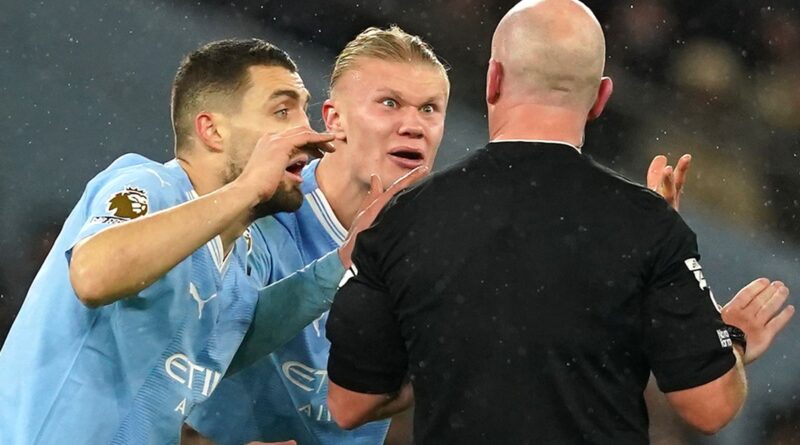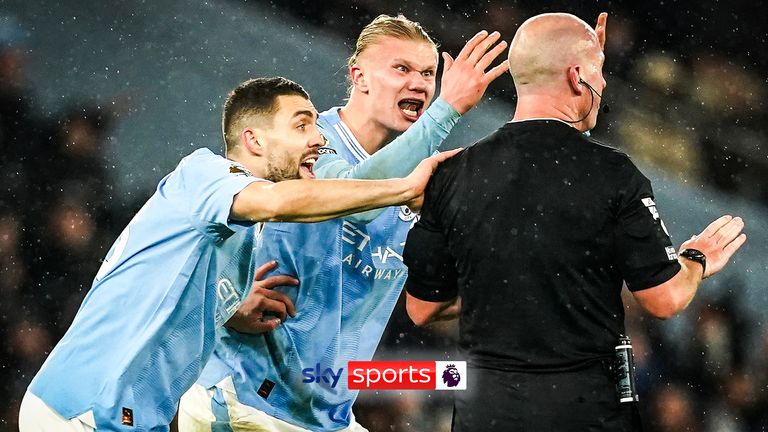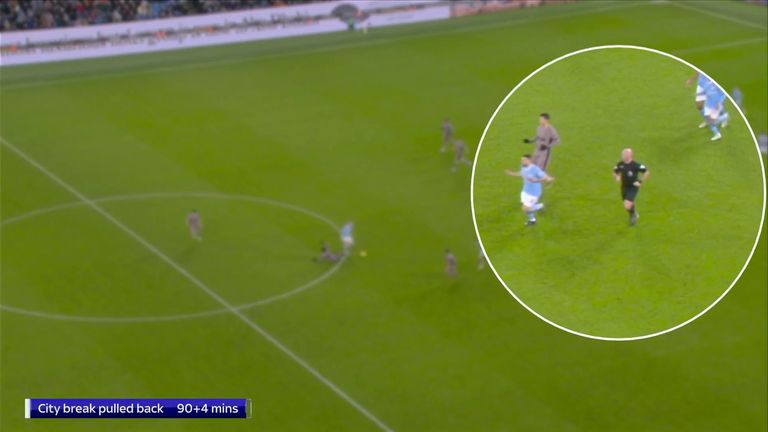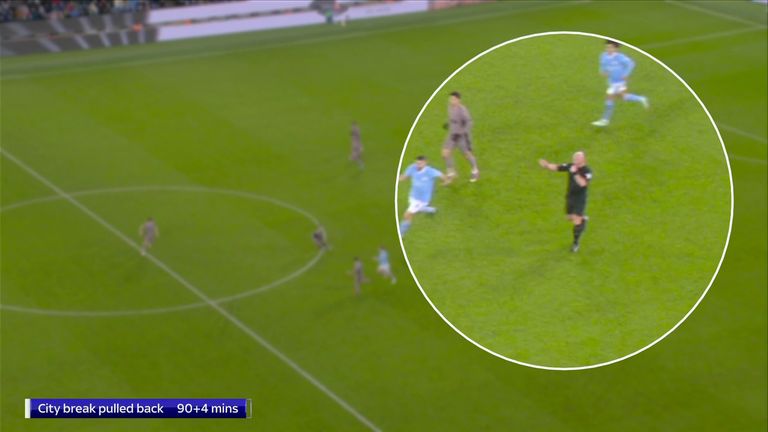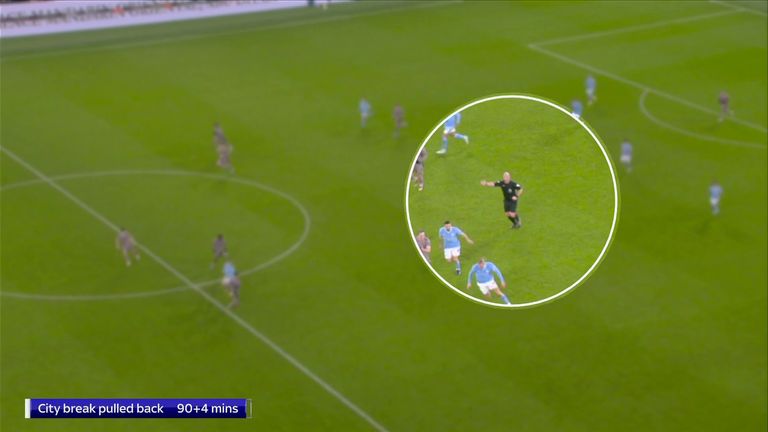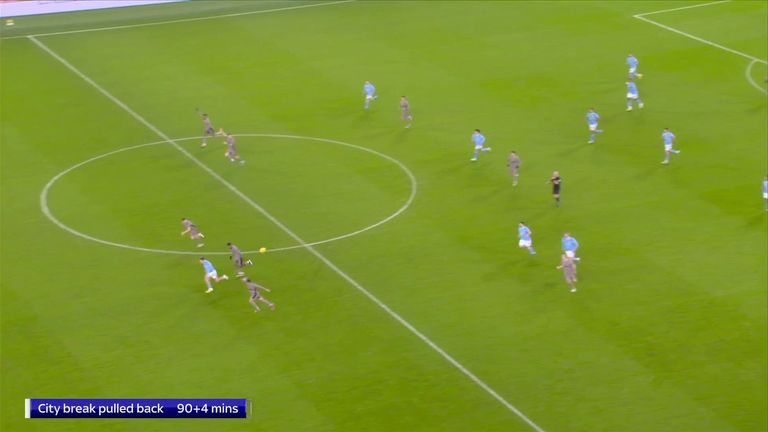Match Officials Mic’d Up: Howard Webb reviews controversy in Man City vs Spurs draw & Kai Havertz’s disallowed goal
In the latest instalment of Match Officials: Mic’d Up, PGMOL chief Howard Webb explains why Manchester City were denied a clear one-on-one late on against Tottenham, why Kai Havertz’s late goal for Arsenal at Aston Villa was ruled out and more.
In full: Webb’s analysis on Man City’s one-on-one vs Tottenham pulled back
Erling Haaland plays Jack Grealish through on goal for a one-on-one late in Man City’s 3-3 draw with Spurs, but referee Simon Hooper pulls play back for a foul on Haaland by Emerson Royal.
See the referee audio of the incident, including Haaland’s furious reaction to the call.
Howard Webb: “It is an officiating mistake.
“As officials, we’re always looking to have that positive impact on the game by trying to identify occasions when we can allow the game to play through an advantage and Simon Hooper is normally good at identifying those things.
“On this occasion, he sees a pretty strong, reckless foul by Emerson Royal on Haaland and it’s in midfield and the ball comes backwards. He does the hard work and just hesitates for a moment to see whether an advantage is possible. And he recognises it by going through his mind that it was a strong challenge, it was reckless and he is going to have to caution [Royal].
“At ground level, it’s not quite easy to see how things are playing out compared to an elevated view. And he decides to penalise just at the moment when the ball is about to go and then realises that a wonderful advantage was available. For sure, he was devastated. He refereed the game really well for 93 minutes but he knows this is going to be the only talking point, right at the end of the game.
“I understand the disappointment that Manchester City felt on this one, because it would have been a wonderful advantage but he [Hooper] blew at the wrong time.
“It looked like he was ready to play advantage, but you never heard him shout: ‘advantage’. I asked him about the arm and he said he didn’t even realise he was doing it in the moment. It was disappointing for Simon, he would have loved to have played advantage there.
“I said to him afterwards: ‘just hold your hands up, be a remorseful man and show your disappointment in the moment’. Because he was certainly feeling that at the time. We took the learning from that and we hope he won’t do that again.”
In full: Webb’s analysis on Kai Havertz’s disallowed goal in Aston Villa 1-0 Arsenal
Kai Havertz thinks he has scored a late equaliser for Arsenal at Aston Villa but is penalised for a handball in the build-up. VAR agrees with the decision.
Howard Webb: “The law states that any contact with an attacker’s hand or arm, which leads to a goal immediately, has to be penalised. This is a really good on-field decision in that respect. The law requires him to penalise when he sees that contact on Kai Havertz’s arm.
“It’s not intentional, but it still has to be penalised. We see this kind of situation and yet seconds earlier it hits Matty Cash’s arm and he doesn’t get penalised – he can’t be penalised because he has to commit a different kind of offence as a defender, naturally bigger or deliberately handball it.
“The law is constantly under review, maybe it will change, but in this circumstance the decision has been given as a disallowed goal, VAR checks the footage, and they see an angle where the ball hits Havertz’s arm.
“Interestingly, if Eddie Nketiah had scored the goal, it would have stood. It only relates to the goalscorer – in this case Havertz.”
In full: Webb’s analysis on Crystal Palace’s penalty against Liverpool
Jean-Philippe Mateta goes down under Jarell Quansah’s challenge in the box and the referee waves it away, until the VAR tells him to go to the monitor and a penalty is then awarded.
Howard Webb: “I think that’s a very clear penalty-kick situation, not seen by the on-field referee in real time and the VAR is there to check for that. There is significant contact by Quansah into the back of Mateta, who is the only one to touch the ball.
“Play continues because the referee waves away the penalty appeal. As the game is continuing the VAR is checking the angles available to see if there is a clear and obvious error, and recognises that there is one.
“I think a better way to do this would be to stop the game at that moment as soon as the VAR has recognised that a review is going to be needed for the penalty. That stops anything else happening in the game, it gets us away from this feeling that it’s taking a long time to check this and I think going forward that’s what we’d rather see. It would make the process a bit more efficient.”
In full: Webb’s analysis of Manchester United’s penalty against Everton
Anthony Martial goes down under Ashley Young’s challenge. Referee John Brooks gives Martial a yellow card for simulation as he feels Young “hasn’t made a challenge”. VAR disagrees and sends Brooks to the monitor, who cancels the booking and gives a penalty to United.
Howard Webb: “These calls can be tough, they happen quickly so you have to make a decision quickly. In this situation, referee John Brooks believes that Ashley Young had retracted his leg, when he hadn’t. He did eventually but it was still there.
“If it’s in those grey zones where there’s a bit of a reach out by the defender, a bit of an action by the attacker and it’s not clear, we’ll leave it alone and leave it to the on-field official. But in this case, we feel it is clear – Young does step into the path of Martial, who is going in a straight line and doesn’t try to find the leg of Young. It’s a tripping action and we see the referee issues a yellow card for simulation for Martial – and the video shows something quite different.
“So we feel this is quite a good use of VAR to rectify a clearly wrong on-field judgement.”
In full: Webb’s analysis of Chelsea’s penalty against Brighton
Chelsea’s Mykhailo Mudryk goes down under a James Milner challenge and referee Craig Pawson does not give a penalty as he deems it to be “shoulder to shoulder”. VAR Jared Gillett spots contact with the legs and recommends an on-field review, leading Pawson to give a penalty and Milner a yellow card.
Howard Webb: “Not everyone thought it was quite at the threshold for VAR intervention, but I thought it was. The footage shows that Mudryk knocks the ball forward, he’s running onto the ball, he’s got the pace to get there and Milner goes into Mudryk and takes him out. For me it’s a clear foul and a correct recommendation.
“If you commit a DOGSO offence (denying an obvious goalscoring opportunity), if it’s cynical, it should be a red card. But in this case, the referee has deemed Milner to be attempting to challenge for the ball, which makes it worthy of a yellow card. It wasn’t a cynical action, he was trying to challenge for the ball.”

